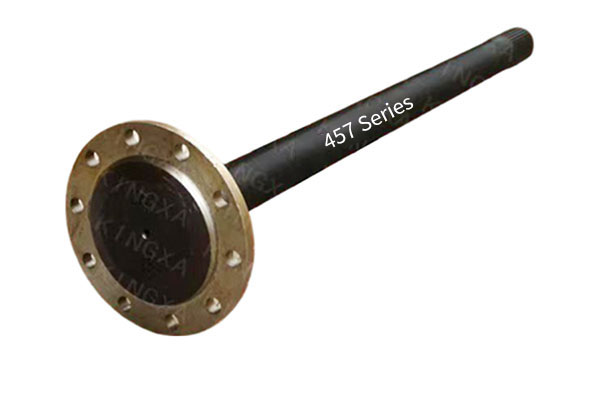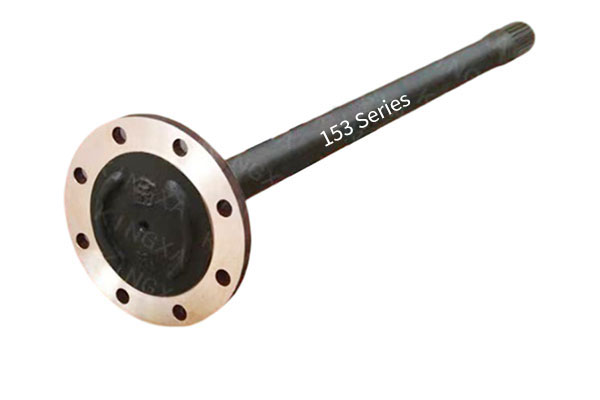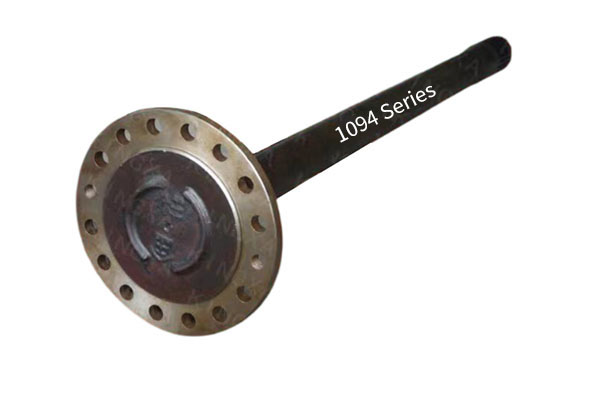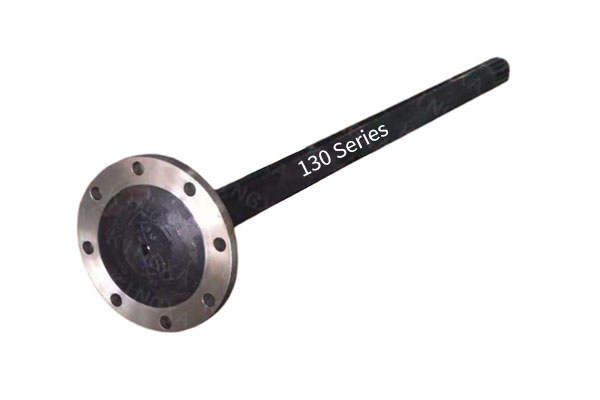How does a mid-size car rear axle half shaft help balance the power distribution between the left and right drive wheels?
Release Time : 2025-05-26
The mid-size car rear axle half shaft plays a vital role in the vehicle powertrain. It is not only responsible for transmitting the power output of the differential to the left and right drive wheels, but also plays a key role in balancing the power distribution between the left and right drive wheels. Through precision design and manufacturing, this component ensures that the vehicle can maintain optimal performance under various driving conditions, providing a smoother and safer driving experience.
First, understanding how the half shaft affects power distribution requires starting from the role of the differential. The differential allows the left and right drive wheels to rotate at different speeds. This is because the outer wheel needs to travel a longer distance than the inner wheel when turning. If the wheels on both sides are forced to rotate at the same speed, it will cause increased tire wear and even difficult handling. The half shaft, as a key component connecting the differential and the drive wheels, plays a bridge role in this process. It not only needs to transmit power accurately and accurately, but also needs to be able to adapt to the speed differences caused by different driving conditions. Therefore, high-quality half shaft design takes this into account to ensure smooth power transmission even in complex road conditions.
Secondly, modern car axles are made of high-strength materials and advanced manufacturing processes, which makes them extremely rigid and flexible. Rigidity ensures direct and efficient power transmission, while flexibility helps absorb the impact of uneven roads and avoid damage to the drivetrain due to sudden changes in force. This feature is particularly important for balancing the power distribution between the left and right drive wheels. Because when the vehicle passes over bumpy roads or encounters a tire slip on one side, a good axle can maintain sufficient strength while deforming appropriately to adapt to dynamic changes, ensuring that power can be continuously and stably distributed to both drive wheels.
Furthermore, considering the complex situations in actual applications, such as a wheel may get stuck in mud or ice-covered ground and lose traction, the differential will automatically direct more power to the side with better grip. However, if the axle cannot effectively cope with this situation, it may cause power loss or mechanical failure. Therefore, the design of high-quality axles takes these extreme situations into account, and improves torsion resistance and durability by optimizing its structure and material selection. In this way, even in the face of harsh road conditions, the axle can ensure that power is reasonably distributed according to demand, avoiding the risk of unilateral overload or failure.
In addition, in order to further improve the performance of the half-shaft in power distribution, manufacturers will also introduce some innovative technologies. For example, some high-end models are equipped with limited slip differentials (LSD) or electronically controlled differential locks (E-LSD), which can automatically adjust the power distribution ratio when the difference in wheel speed on both sides is detected. Although these functions are mainly performed by the differential, the half-shaft, as the last link of power transmission, must be able to perfectly cooperate with the operation of these advanced systems. This means that the half-shaft must not only have basic power transmission capabilities, but also be able to withstand higher torque fluctuations and frequent changes.
Finally, it cannot be ignored that the design of the half-shaft must also take into account the balance between daily maintenance and durability. An excellent half-shaft product should be easy to inspect and maintain, and have a long service life. This can not only reduce the cost of use for car owners, but also reduce the inconvenience caused by repairs or replacements. In the long-term use process, a stable power distribution mechanism depends on the close cooperation between various components, and reliable half-shafts are an indispensable part of it. Through regular maintenance and correct use methods, the function of the half-shaft can be maximized, its service life can be extended, and the healthy operation of the entire transmission system can be guaranteed.
In short, mid-size car rear axle half shaft plays a vital role in helping to balance the power distribution between the left and right drive wheels. With its excellent design, selected materials and advanced manufacturing process, the half shaft not only achieves efficient power transmission, but also enhances the vehicle's handling stability and improves driving safety. Whether in daily commuting or long-distance travel, high-quality half shafts are one of the important factors to ensure the smooth operation of the vehicle. With the advancement of technology, the design of future half shafts will be more intelligent and efficient, bringing unprecedented comfort and peace of mind to drivers.
First, understanding how the half shaft affects power distribution requires starting from the role of the differential. The differential allows the left and right drive wheels to rotate at different speeds. This is because the outer wheel needs to travel a longer distance than the inner wheel when turning. If the wheels on both sides are forced to rotate at the same speed, it will cause increased tire wear and even difficult handling. The half shaft, as a key component connecting the differential and the drive wheels, plays a bridge role in this process. It not only needs to transmit power accurately and accurately, but also needs to be able to adapt to the speed differences caused by different driving conditions. Therefore, high-quality half shaft design takes this into account to ensure smooth power transmission even in complex road conditions.
Secondly, modern car axles are made of high-strength materials and advanced manufacturing processes, which makes them extremely rigid and flexible. Rigidity ensures direct and efficient power transmission, while flexibility helps absorb the impact of uneven roads and avoid damage to the drivetrain due to sudden changes in force. This feature is particularly important for balancing the power distribution between the left and right drive wheels. Because when the vehicle passes over bumpy roads or encounters a tire slip on one side, a good axle can maintain sufficient strength while deforming appropriately to adapt to dynamic changes, ensuring that power can be continuously and stably distributed to both drive wheels.
Furthermore, considering the complex situations in actual applications, such as a wheel may get stuck in mud or ice-covered ground and lose traction, the differential will automatically direct more power to the side with better grip. However, if the axle cannot effectively cope with this situation, it may cause power loss or mechanical failure. Therefore, the design of high-quality axles takes these extreme situations into account, and improves torsion resistance and durability by optimizing its structure and material selection. In this way, even in the face of harsh road conditions, the axle can ensure that power is reasonably distributed according to demand, avoiding the risk of unilateral overload or failure.
In addition, in order to further improve the performance of the half-shaft in power distribution, manufacturers will also introduce some innovative technologies. For example, some high-end models are equipped with limited slip differentials (LSD) or electronically controlled differential locks (E-LSD), which can automatically adjust the power distribution ratio when the difference in wheel speed on both sides is detected. Although these functions are mainly performed by the differential, the half-shaft, as the last link of power transmission, must be able to perfectly cooperate with the operation of these advanced systems. This means that the half-shaft must not only have basic power transmission capabilities, but also be able to withstand higher torque fluctuations and frequent changes.
Finally, it cannot be ignored that the design of the half-shaft must also take into account the balance between daily maintenance and durability. An excellent half-shaft product should be easy to inspect and maintain, and have a long service life. This can not only reduce the cost of use for car owners, but also reduce the inconvenience caused by repairs or replacements. In the long-term use process, a stable power distribution mechanism depends on the close cooperation between various components, and reliable half-shafts are an indispensable part of it. Through regular maintenance and correct use methods, the function of the half-shaft can be maximized, its service life can be extended, and the healthy operation of the entire transmission system can be guaranteed.
In short, mid-size car rear axle half shaft plays a vital role in helping to balance the power distribution between the left and right drive wheels. With its excellent design, selected materials and advanced manufacturing process, the half shaft not only achieves efficient power transmission, but also enhances the vehicle's handling stability and improves driving safety. Whether in daily commuting or long-distance travel, high-quality half shafts are one of the important factors to ensure the smooth operation of the vehicle. With the advancement of technology, the design of future half shafts will be more intelligent and efficient, bringing unprecedented comfort and peace of mind to drivers.







